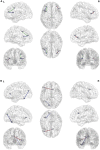Changes in the geometry and robustness of diffusion tensor imaging networks: Secondary analysis from a randomized controlled trial of young autistic children receiving an umbilical cord blood infusion
- PMID: 36353577
- PMCID: PMC9637553
- DOI: 10.3389/fpsyt.2022.1026279
Changes in the geometry and robustness of diffusion tensor imaging networks: Secondary analysis from a randomized controlled trial of young autistic children receiving an umbilical cord blood infusion
Abstract
Diffusion tensor imaging (DTI) has been used as an outcome measure in clinical trials for several psychiatric disorders but has rarely been explored in autism clinical trials. This is despite a large body of research suggesting altered white matter structure in autistic individuals. The current study is a secondary analysis of changes in white matter connectivity from a double-blind placebo-control trial of a single intravenous cord blood infusion in 2-7-year-old autistic children (1). Both clinical assessments and DTI were collected at baseline and 6 months after infusion. This study used two measures of white matter connectivity: change in node-to-node connectivity as measured through DTI streamlines and a novel measure of feedback network connectivity, Ollivier-Ricci curvature (ORC). ORC is a network measure which considers both local and global connectivity to assess the robustness of any given pathway. Using both the streamline and ORC analyses, we found reorganization of white matter pathways in predominantly frontal and temporal brain networks in autistic children who received umbilical cord blood treatment versus those who received a placebo. By looking at changes in network robustness, this study examined not only the direct, physical changes in connectivity, but changes with respect to the whole brain network. Together, these results suggest the use of DTI and ORC should be further explored as a potential biomarker in future autism clinical trials. These results, however, should not be interpreted as evidence for the efficacy of cord blood for improving clinical outcomes in autism. This paper presents a secondary analysis using data from a clinical trial that was prospectively registered with ClinicalTrials.gov(NCT02847182).
Keywords: biomarkers; clinical trial; diffusion tensor imaging; stem cells; white matter.
Copyright © 2022 Simhal, Carpenter, Kurtzberg, Song, Tannenbaum, Zhang, Sapiro and Dawson.
Conflict of interest statement
Authors KC, GS, and GD reported technology unrelated to the submitted work that has been licensed, have benefited financially from this license, and have a patent. Authors GD, AS, and JK had a patent and have developed technology, data, and/or products that have been licensed to Cryocell, Inc., from which they and Duke University have benefited financially. Author JK was the Director of the Carolinas Cord Blood Bank, Medical Director of Cryocell, Inc., and is a paid consultant for Neurogene. Author GS was affiliated with Apple Inc., the work here reported was initiated before such affiliation and it is independent of it. Allen Song has patents licensed unrelated to the submitted work and receives grants from GE Healthcare unrelated to the submitted work. Author GD was on the Scientific Advisory Boards of Akili Interactive, Inc., Zynerba, Nonverbal Learning Disability Project, and Tris Pharma, is a consultant to Apple, Gerson Lehrman Group, and Guidepoint Global, Inc., and receives book royalties from Guilford Press and Springer Nature. Author GD has stock interests in Neuvana, Inc. Author AT was a consultant for Polaris. The remaining authors declare that the research was conducted in the absence of any commercial or financial relationships that could be construed as a potential conflict of interest.
Figures



Similar articles
-
White Matter Tract Changes Associated with Clinical Improvement in an Open-Label Trial Assessing Autologous Umbilical Cord Blood for Treatment of Young Children with Autism.Stem Cells Transl Med. 2019 Feb;8(2):138-147. doi: 10.1002/sctm.18-0251. Epub 2019 Jan 8. Stem Cells Transl Med. 2019. PMID: 30620122 Free PMC article. Clinical Trial.
-
Measuring robustness of brain networks in autism spectrum disorder with Ricci curvature.Sci Rep. 2020 Jul 2;10(1):10819. doi: 10.1038/s41598-020-67474-9. Sci Rep. 2020. PMID: 32616759 Free PMC article.
-
Atypical structural connectivity of language networks in autism spectrum disorder: A meta-analysis of diffusion tensor imaging studies.Autism Res. 2022 Sep;15(9):1585-1602. doi: 10.1002/aur.2789. Epub 2022 Aug 13. Autism Res. 2022. PMID: 35962721 Free PMC article. Review.
-
Effect of Autologous Cord Blood Infusion on Motor Function and Brain Connectivity in Young Children with Cerebral Palsy: A Randomized, Placebo-Controlled Trial.Stem Cells Transl Med. 2017 Dec;6(12):2071-2078. doi: 10.1002/sctm.17-0102. Epub 2017 Oct 28. Stem Cells Transl Med. 2017. PMID: 29080265 Free PMC article. Clinical Trial.
-
White Matter-Based Structural Brain Network of Major Depression.Adv Exp Med Biol. 2021;1305:35-55. doi: 10.1007/978-981-33-6044-0_3. Adv Exp Med Biol. 2021. PMID: 33834393 Review.
Cited by
-
Discrete Ricci curvatures capture age-related changes in human brain functional connectivity networks.Front Aging Neurosci. 2023 May 24;15:1120846. doi: 10.3389/fnagi.2023.1120846. eCollection 2023. Front Aging Neurosci. 2023. PMID: 37293668 Free PMC article.
-
ORCO: Ollivier-Ricci Curvature-Omics-an unsupervised method for analyzing robustness in biological systems.Bioinformatics. 2025 Mar 4;41(3):btaf093. doi: 10.1093/bioinformatics/btaf093. Bioinformatics. 2025. PMID: 40036763 Free PMC article.
-
Gene interaction network analysis in multiple myeloma detects complex immune dysregulation associated with shorter survival.Blood Cancer J. 2023 Nov 30;13(1):175. doi: 10.1038/s41408-023-00935-2. Blood Cancer J. 2023. PMID: 38030619 Free PMC article.
-
ORCO: Ollivier-Ricci Curvature-Omics - an unsupervised method for analyzing robustness in biological systems.bioRxiv [Preprint]. 2024 Oct 11:2024.10.06.616915. doi: 10.1101/2024.10.06.616915. bioRxiv. 2024. Update in: Bioinformatics. 2025 Mar 04;41(3):btaf093. doi: 10.1093/bioinformatics/btaf093. PMID: 39416154 Free PMC article. Updated. Preprint.
-
Stem cell therapy for the treatment of psychiatric disorders: a real hope for the next decades.Front Psychiatry. 2025 Jan 7;15:1492415. doi: 10.3389/fpsyt.2024.1492415. eCollection 2024. Front Psychiatry. 2025. PMID: 39839136 Free PMC article. Review.
References
-
- Dawson G, Sun JM, Baker J, Carpenter K, Compton S, Deaver M, et al. A phase ii randomized clinical trial of the safety and efficacy of intravenous umbilical cord blood infusion for treatment of children with autism spectrum disorder. J Pediatr. (2020) 222:164–73 e5. 10.1093/ijnp/pyz059 - DOI - PubMed
Associated data
Grants and funding
LinkOut - more resources
Full Text Sources
Medical

